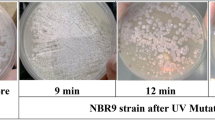Summary
Beijerinckia indica var.penicillanicum mutant UREMS-5, producing 168% more penicillin V acylase, was obtained by successive treatment with UV, γ-irradiation and ethylmethane sulfonate. Penicillin V acylase production by the mutant strain was resistant to catabolite repression by glucose. Incorporation of glucose, sodium glutamate and vegetable oils in the medium enhanced enzyme production. The maximum specific production of penicillin V acylase was 244 IU/g dry weight of cells. Effect of solvents on hydrolysis of penicillin V by soluble penicillin V acylase and whole cells was studied. Methylene chloride, chloroform and carbon tetrachloride significantly stimulated the rate of penicillin V hydrolysis by whole cells.
Similar content being viewed by others
References
Carlson, F. and C. Emborg. 1981.Bacillus sphaericus V penicillin acylase. 1. Fermentation. Biotechnol. Lett. 3: 375–378.
Diers, I.V. and C. Emborg. 1979. Penicillin V acylase. Br. UK Patent Appl. 2, 021, 119.
Gachelin, G. 1969. A new assay of the phosphotransferase system inEscherichia coli. Biochem. Biophys. Res. Commun. 34: 382–389.
Gestrelius, S., B.H. Nielsen and H. Mollgaard. 1983. Continuous 6-APA and 7-ADCA production using Semacylase (Immobilized Pen V acylase). Ann. N.Y. Acad. Sci. 413: 554–556.
Kasche, V. 1986. Mechanism and yields in enzyme catalysed equilibrium and kinetically controlled synthesis of beta-lactam antibiotics, peptides and other condensation products. Enzyme Microb. Technol. 8: 4–16.
Khmelitsky, Yu. L., A.V. Levashow, N.L. Klyachko and K. Martinek. 1988. Engineering biocatalytic systems in organic media with low water content. Enzyme Microb. Technol. 10: 710–724.
Lowe, D.A., G. Romancik and R.D. Elander. 1981. Penicillin acylases—A review of existing enzymes and the isolation of a new bacterial penicillin V acylase. Dev. Industr. Microbiol. 22: 163–180.
Martin, C.K.A. and D. Perlman, 1975. Stimulation by organic solvents and detergents of conversion ofL-sorbose tol-sorbosone byGluconobacter melanogenus IFO 3293. Biotechnol. Bioeng. 17: 1473–1483.
McDougall, B., P. Dunnill and M.D. Lilly, 1982. Enzymic acylation of 6-aminopenicillanic acid. Enzyme Microb. Technol. 4: 114–117.
Nam, D.H. and D.D.Y. Ryu. 1984. Enzymatic synthesis of phenoxymethyl penicillin usingErwinia aroidae enzyme. J. Antibiot. 37: 1217–1223.
Rolinson, G.N. 1988. The influence of 6-aminopenicillanic acid on antibiotic development. J. Antimicrob. Chemother. 22: 5–14.
Schneider, W.J., and M. Roehr. 1976. Purification and properties of penicillin acylase ofBovista plumbea. Biochim. Biophys. Acta. 452: 177–185.
Shewale, J.G. and H. SivaRaman. 1989. Penicillin acylase: enzyme production and its application in the manufacture of 6-APA. Process Biochem. 24: 146–154.
Shewale, J.G., K.K. Kumar and G.R. Ambekar. 1987. Evaluation of determination of 6-aminopenicillanic acid byp-dimethylaminobenzaldehyde. Biotechnol. Tech. 1: 69–72.
Stoppock, E., U. Schomer, A. Segmer, H. Meyer and F. Wagner. 1981. Production of 6-APA from penicillin V and penicillin G byBovista plumbea NRRL 3824 andEscherichia coli 5K (ph M12). In: Advances in Biotechnology, Vol. III, (M. Moo-Young, ed.), pp. 547–552. Pergamon Press, Toronto.
Stoppock, E. and F. Wagner. 1983. The effect of citrate on the synthesis of penicillin V acylase ofPleurotus ostreatus Biotechnol. Lett. 5: 503–508.
Sudhakaran, V.K. and P.S. Borkar. 1984. Phenoxymethyl penicillin acylase: Sources and study—A sum up. Hind. Antibiot. Bull. 27: 44–62.
Sudhakaran, V.K. and J.G. Shewale. 1990. Effect of culture conditions on penicillin V acylase production byBeijerinckia indica var.penicillanicum. J. Microb. Biotechnol. 5: 66–74.
Tadashi, K. 1975. 6-APA. Japanese Patent. 75 11,477.
Vandamme, E.J. 1988. Immobilized biocatalysts and antibiotic production: Biochemical, genetical and biotechnical aspects. In: Bioreactor, Immobilized Enzymes and Cells: Fundamentals and Applications. (M. Moo-Young, ed.), pp. 261–286. Elsevier, New York, N.Y.
Vanderhaeghe, H., M. Claesen, A. Vlietinck and G. Parmentier. 1968. Specificity of penicillin acylase ofFusarium andPenicillium chrysogenum. Appl. Microbiol. 16: 1557–1563.
Author information
Authors and Affiliations
Rights and permissions
About this article
Cite this article
Ambedkar, S.S., Deshpande, B.S., Sudhakaran, V.K. et al. Beijerinckia indica var.penicillanicum penicillin V acylase: enhanced enzyme production by catabolite repression-resistant mutant and effect of solvents on enzyme activity. Journal of Industrial Microbiology 7, 209–214 (1991). https://doi.org/10.1007/BF01575885
Received:
Revised:
Accepted:
Issue Date:
DOI: https://doi.org/10.1007/BF01575885




